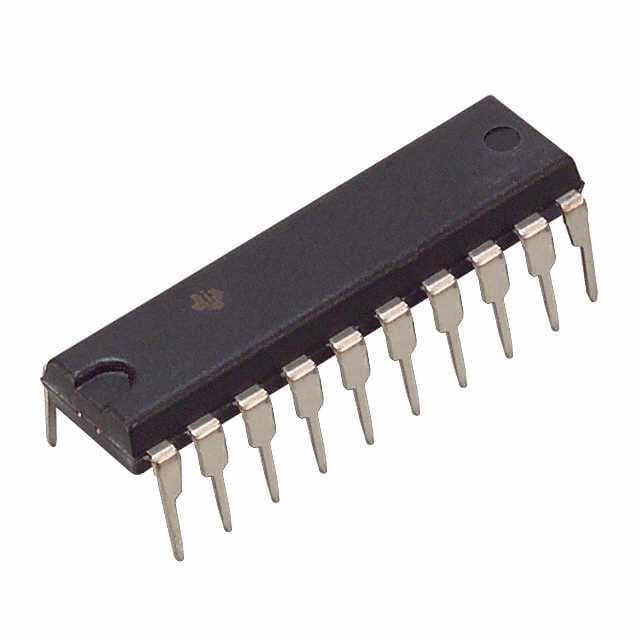SN74AC574NG4
Product Overview
Category
SN74AC574NG4 belongs to the category of integrated circuits (ICs).
Use
This product is commonly used in digital electronic systems for data storage and transfer.
Characteristics
- High-speed operation
- Low power consumption
- Wide operating voltage range
- Schmitt-trigger inputs for noise immunity
- 8-bit D-type flip-flop with 3-state outputs
Package
SN74AC574NG4 is available in a standard 20-pin plastic dual in-line package (PDIP).
Essence
The essence of SN74AC574NG4 lies in its ability to store and transfer digital data efficiently within electronic systems.
Packaging/Quantity
This product is typically packaged in reels or tubes, with a quantity of 250 units per reel/tube.
Specifications
- Supply Voltage: 2V to 6V
- Input Voltage: 0V to VCC
- Output Voltage: 0V to VCC
- Operating Temperature Range: -40°C to +85°C
- Maximum Clock Frequency: 100MHz
Detailed Pin Configuration
- GND (Ground)
- D0 (Data Input 0)
- D1 (Data Input 1)
- D2 (Data Input 2)
- D3 (Data Input 3)
- D4 (Data Input 4)
- D5 (Data Input 5)
- D6 (Data Input 6)
- D7 (Data Input 7)
- OE (Output Enable)
- CP (Clock Pulse)
- MR (Master Reset)
- Q0 (Flip-Flop Output 0)
- Q1 (Flip-Flop Output 1)
- Q2 (Flip-Flop Output 2)
- Q3 (Flip-Flop Output 3)
- Q4 (Flip-Flop Output 4)
- Q5 (Flip-Flop Output 5)
- Q6 (Flip-Flop Output 6)
- VCC (Supply Voltage)
Functional Features
- 8-bit data storage and transfer
- 3-state outputs for bus-oriented applications
- Schmitt-trigger inputs for improved noise immunity
- Master reset for synchronous reset of all flip-flops
- Output enable for disabling the outputs
Advantages and Disadvantages
Advantages
- High-speed operation allows for efficient data transfer
- Low power consumption helps in reducing energy usage
- Wide operating voltage range provides flexibility in different systems
- Schmitt-trigger inputs enhance noise immunity, ensuring reliable operation
- 3-state outputs enable easy integration into bus-oriented applications
Disadvantages
- Limited number of flip-flops (8-bit) may not be suitable for larger data storage requirements
- PDIP package may not be ideal for space-constrained designs
Working Principles
SN74AC574NG4 operates based on the principles of D-type flip-flops. The clock pulse (CP) triggers the flip-flops to latch the input data (D0-D7). The latched data is then available at the corresponding output pins (Q0-Q7). The output enable (OE) pin controls whether the outputs are active or in a high-impedance state. The master reset (MR) pin resets all flip-flops synchronously when activated.
Detailed Application Field Plans
SN74AC574NG4 finds applications in various digital electronic systems, including but not limited to: - Microcontrollers - Data communication systems - Memory modules - Industrial automation - Automotive electronics
Detailed and Complete Alternative Models
Some alternative models that offer similar functionality to SN74AC574NG4 are: - 74HC574 - CD74AC574 - MC74AC574 - SN54AC574
These models can be considered as alternatives based on specific requirements and availability.
Word count: 510 words
Lista 10 Vanliga frågor och svar relaterade till tillämpningen av SN74AC574NG4 i tekniska lösningar
Sure! Here are 10 common questions and answers related to the application of SN74AC574NG4 in technical solutions:
Q: What is SN74AC574NG4? A: SN74AC574NG4 is a type of octal D-type flip-flop integrated circuit (IC) that can store and transfer data in digital systems.
Q: What is the purpose of SN74AC574NG4? A: SN74AC574NG4 is commonly used for data storage, synchronization, and signal buffering in various electronic applications.
Q: What voltage levels does SN74AC574NG4 support? A: SN74AC574NG4 supports a wide range of voltage levels, typically from 2V to 6V.
Q: How many flip-flops are there in SN74AC574NG4? A: SN74AC574NG4 consists of 8 individual D-type flip-flops, making it an octal (8-bit) device.
Q: Can SN74AC574NG4 be cascaded to increase the number of flip-flops? A: Yes, multiple SN74AC574NG4 ICs can be cascaded together to increase the number of flip-flops in a system.
Q: What is the maximum clock frequency supported by SN74AC574NG4? A: SN74AC574NG4 can operate at clock frequencies up to 100 MHz, depending on the specific operating conditions.
Q: Does SN74AC574NG4 have any special features? A: Yes, SN74AC574NG4 has features like asynchronous clear and preset inputs, which allow for easy initialization of the flip-flops.
Q: Can SN74AC574NG4 handle both rising and falling edge-triggered inputs? A: Yes, SN74AC574NG4 supports both rising and falling edge-triggered inputs, providing flexibility in system design.
Q: What is the power supply voltage range for SN74AC574NG4? A: SN74AC574NG4 typically operates with a power supply voltage range of 2V to 6V.
Q: What are some common applications of SN74AC574NG4? A: SN74AC574NG4 is commonly used in microcontrollers, data storage systems, communication interfaces, and other digital logic circuits where data synchronization and storage are required.
Please note that these answers are general and may vary depending on specific datasheet specifications and application requirements.


